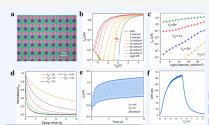Recently, the research team of Yang Tao and Yang Xiaoguang from the Materials Science Key Laboratory of the Institute of Semiconductors has made important research progress in silicon-based epitaxial quantum dot lasers and their doping regulation.
Silicon-based optoelectronic integrated chips are based on mature, highly integrated, and low-cost CMOS technology, and integrate a large number of functional devices required by traditional optical systems on the same chip at high density, greatly improving the information transmission and processing capabilities of the chip , can be widely used in emerging fields such as ultra-large data centers, 5G, Internet of Things, supercomputers, and artificial intelligence. Due to the low luminous efficiency of silicon (Si) materials, epitaxy of III-V semiconductor materials with high luminous efficiency such as gallium arsenide (GaAs) on a CMOS-compatible Si-based substrate, and the epitaxy and preparation of lasers are recognized as optimal On-chip light source solution. Due to the large lattice mismatch, polarity mismatch and thermal expansion coefficient mismatch between Si and GaAs materials, the development of high-performance silicon-based epitaxial lasers needs to solve a series of key scientific and technical difficulties.
Recently, the research team of Yang Tao and Yang Xiaoguang from the Materials Science Key Laboratory of the Institute of Semiconductors has made important research progress in silicon-based epitaxial quantum dot lasers and their doping regulation. The team used molecular beam epitaxy technology to reduce the defect density of silicon-based GaAs materials to the order of 106cm-2 under the condition that the total thickness of the buffer layer is 2700nm. The stacked InAs/GaAs quantum dot structure is used as the active region, and the domain-divided double doping control technology of "p-type modulation doping + direct Si doping" is proposed and applied to the active region for the first time, and a high-temperature working low-power on-chip light source. At room temperature, the continuous output power of the device exceeds 70mW, and the threshold current is 30% lower than that of the p-type doped laser with the same structure. The maximum continuous operating temperature of the device exceeds 115°C, which is the highest value of similar devices in public reports so far. The above technologies and results provide a key solution and core light source for realizing ultra-low power consumption, high temperature stable high-density silicon-based optoelectronic integrated chips.

